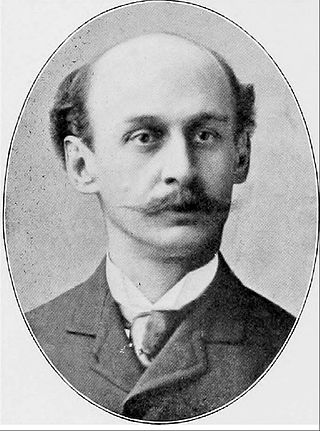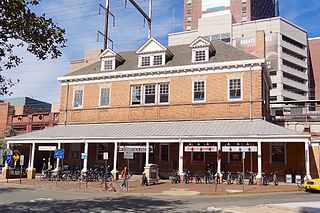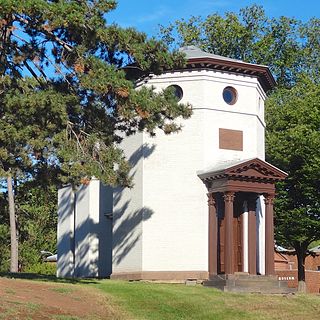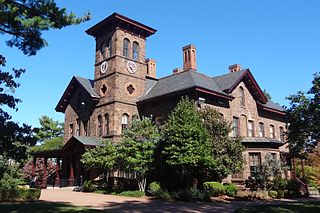
New Brunswick is a city in and the seat of government of Middlesex County, in the U.S. state of New Jersey. The city is the home of Rutgers University. The city is both a regional commercial hub for central New Jersey and a prominent and growing commuter town for residents commuting to New York City within the New York metropolitan area. New Brunswick is on the Northeast Corridor rail line, 27 miles (43 km) southwest of Manhattan. The city is located on the southern banks of the Raritan River in the Raritan Valley region.

Morristown is a town and the county seat of Morris County, in the U.S. state of New Jersey. Morristown has been called "the military capital of the American Revolution" because of its strategic role in the war for independence from Great Britain. Today this history is visible in a variety of locations throughout the town that collectively make up Morristown National Historical Park.

Henry Janeway Hardenbergh was an American architect, best known for his hotels and apartment buildings, and as a "master of a new building form — the skyscraper."

Buccleuch Mansion is located in Buccleuch Park in New Brunswick in Middlesex County, New Jersey, along the Raritan River.

New Brunswick station is a railroad station in New Brunswick, New Jersey. It serves Amtrak and NJ Transit trains on the Northeast Corridor. The station is located at the intersection of Easton Avenue and French and Albany Streets, near the College Avenue Campus of Rutgers University.

The Henry Guest House is in New Brunswick, Middlesex County, New Jersey, at Livingston Avenue and Morris Street. It was originally located on New Street between Livingston Avenue and George Street. The Georgian stone farmhouse was built in 1760 by Henry Guest. He was a New Brunswick alderman and an associate of John Adams and author Thomas Paine. It was added to the National Register of Historic Places on May 24, 1976.

Detlef Lienau was a German architect born in Holstein. He is credited with having introduced the French style to American building construction, notably the mansard roof and all its decorative flourishes. Trained at the École des Beaux-Arts, Paris, he designed virtually every type of Victorian structure—cottages, mansions, townhouses, apartment houses, hotels, tenements, banks, stores, churches, schools, libraries, offices, factories, railroad stations, and a museum. Lienau was recognized by clients and colleagues alike as one of the most creative and technically proficient architects of the period, and was one of the 29 founding members of the American Institute of Architects.

Old Queens is the oldest extant building at Rutgers University and is the symbolic heart of the university's campus in New Brunswick in Middlesex County, New Jersey in the United States. Rutgers, the eighth-oldest college in the United States, was founded in 1766 during the American colonial period as Queen's College. Queen's College was named for Charlotte of Mecklenburg-Strelitz, the daughter of a German duke who became the queen consort of British king George III. Old Queens is located on a six-acre hilltop city block bounded by Somerset Street, Hamilton Street, College Avenue and George Street that was previously an apple orchard. Donated to the college in 1807 by James Parker, Jr., this city block become known the Queen's Campus and is the historic core of the university. Because of this, by metonymy, the name "Old Queens" came to be used as a reference to Rutgers College and is often invoked as an allusive reference to the university or to its administration.

Samuel Sloan was a Philadelphia-based architect and best-selling author of architecture books in the mid-19th century. He specialized in Italianate villas and country houses, churches, and institutional buildings. His most famous building—the octagonal mansion "Longwood" in Natchez, Mississippi—is unfinished; construction was abandoned during the American Civil War.
James Bishop was an American Opposition Party politician, who represented New Jersey's 3rd congressional district in the United States House of Representatives from 1855–1857.
Minard Lafever (1798–1854) was an American architect of churches and houses in the United States in the early nineteenth century.

The Sophia Astley Kirkpatrick Memorial Chapel, known as Kirkpatrick Chapel, is the chapel to Rutgers, The State University of New Jersey and located on the university's main campus in New Brunswick, New Jersey in the United States. Kirkpatrick Chapel is among the university's oldest extant buildings, and one of six buildings located on a historic section of the university's College Avenue Campus in New Brunswick known as the Queens Campus. Built in 1872 when Rutgers was a small, private liberal arts college, the chapel was designed by architect Henry Janeway Hardenbergh at the beginning of his career. Hardenbergh, a native of New Brunswick, was the great-great-grandson of Rutgers' first president, the Rev. Jacob Rutsen Hardenbergh. It was the third of three projects that Hardenbergh designed for the college.

The Daniel S. Schanck Observatory is an historical astronomical observatory on the Queens Campus of Rutgers University in New Brunswick, New Jersey, United States, and is tied for the seventh oldest observatory in the US alongside the Vassar College Observatory. It is located on George Street near the corner with Hamilton Street, opposite the parking lot adjacent to Kirkpatrick Chapel, and to the northeast of Old Queens and Geology Hall.

The Queens Campus or Old Queens Campus is a historic section of the College Avenue Campus of Rutgers, The State University of New Jersey in New Brunswick, New Jersey, in the United States.

Charles Alling Gifford was an American architect and a partner in the New York City firm of Gifford & Bates. He is best remembered for his resort hotels, but also designed houses, churches, and five armories for the New Jersey National Guard.

Winants Hall is a historic educational building located on the Queens Campus of Rutgers University in New Brunswick, New Jersey. Designed by Van Campen Taylor and completed in 1890, Winants Hall is the oldest dormitory building at Rutgers University, known then as Rutgers College. The building was a gift to the university from Board of Trustees member and Bayonne businessman, Garrett E. Winants, and cost $75,000. The construction of the dormitory satisfied many long-awaited needs of the college. The new residential system also fostered a thriving social atmosphere for students, staff, and guests as it served as a student dormitory from 1890 to 1947.

The Levi D. Jarrard House is a historic building located on the Douglass College campus of Rutgers University in New Brunswick, New Jersey. It was constructed in 1868 by an unknown architect, as a private residence for Levi D. Jarrard. Levi D Jarrard, was acting as Postmaster of New Brunswick from 1881-1883, but was previously employed as a New Jersey State Senator as well as the Middlesex County Collector. In 1883 he was found to have embezzled approximately $20,000, and had fled to Canada with the funds, leaving his family to struggle with payments on the house. The house was then purchased by John N. Carpender, who would later lease it to the New Jersey College for Women.

Wood Lawn is a historic mansion located off Ryders Lane on the Douglass Campus of Rutgers University in the city of New Brunswick in Middlesex County, New Jersey. The house was added to the National Register of Historic Places on March 8, 1978, for its significance in architecture and education. It is currently used by the Eagleton Institute of Politics.

The Van Horne House is a historic building at 941 East Main Street near Bound Brook in Bridgewater Township, Somerset County, New Jersey. The house was built c. 1750 and also known as Phil's Hill, after its owner, Philip Van Horne. It served as the headquarters for American General Benjamin Lincoln in 1777, during the American Revolutionary War, in particular the Battle of Bound Brook. Later, it served as the headquarters for American General William Alexander, Lord Stirling during the second Middlebrook encampment (1778–79). The house, on the early-18th-century Old York Road that connected Philadelphia to New York City, was a New Jersey landmark during the war. Since 2002, the Heritage Trail Association has used the house as its headquarters, including an exhibit space. It was added to the National Register of Historic Places on March 8, 2002, for its locally significant Colonial Revival architecture from 1937 to 1944.

The Demarest House is a historic building at 542 George Street in New Brunswick, New Jersey on the campus of Rutgers University. It was documented by the Historic American Buildings Survey in 1960. The house was later added to the National Register of Historic Places on August 10, 1977 for its significance in architecture, education, and social history.























